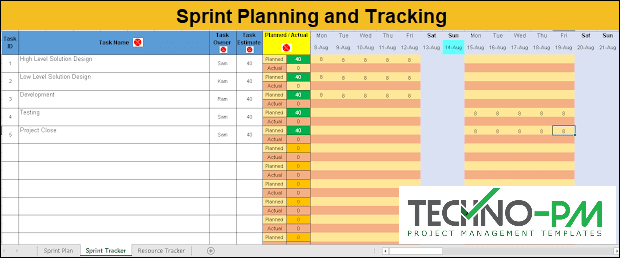Sprint Planning with Excel Template : 10 Meeting Best Practices
Sprint Planning
Sprint planning and tracking is an essential part of Agile Project Management. This template will help in planning, tracking, and resource management for a two-week sprint. The nature of this type of work is cyclical and efficient. Once a team adapts to a few sprint cycles, the time-saving nature of the process becomes apparent. Sprint planning is done in the Sprint Planning Meeting, attended by the Scrum Master, Product Owner, and the project team.

Sprint Planning and Tracking
Sprint Planning Excel Template
Allows planning, tracking, and resource management for a 14 day Sprint. Has different tabs for Planning, tracking, and resource management. Provides a high-level view of the tasks being worked in the sprint. Allows reuse of tasks defined in the planning for the tracking phase. Highlights discrepancies in planned and actual effort. Highlights the current day, which provides a good reference point. Highlights resource utilization: under-utilization and over-utilization. Read-only columns are highlighted with a red cross mark. This template can feed into sprint planning and retrospective meetings.
How to Plan Your Sprints?
- Conduct a Planning session with the team.
- Confirm the scope/tasks, task owners, and estimates.
- Using the template, populate the sprint plan.
- Update the tracker( allocations - planned) and review the resource allocation to ensure all the resources are used optimally.
- Share the plan with the team to make sure there are no gaps.
- As the sprint progress, record the actual effort for each task daily.
Sprint start date is the date on which work will start. This should always be a Monday.
How to Track Sprint Progress?
How to Plan Resources for Your Sprint?
Sprint Planning Meeting
What are the Goals of a Sprint Planning Meeting?
Sprint Planning Meetings have specific purposes and goals. Identify the roles of the Scrum Master and other team resources in the Sprint. Identify the velocity/capacity of team members (any vacations or limitations to team member availability). Establish the Product Backlog Items (PBIs or stories), also known as Agile or Sprint Backlog, to be moved from the product backlog to the sprint backlog for action. Team agreement of the PBIs that will be completed and delivered to the product owner.
Communicate the sprint duration (timebox)—definition of completion requirements – what must be “done” for the product owner. During the sprint planning meeting, all team members must evaluate the PBIs to be delivered and reach a consensus that they are achievable within the sprint's time box. This generates commitment to delivering those products after the sprint.

Sprint Planning Meeting Best Practices
- Leaders experienced in sprint planning meetings will yield the most effective results for the sprint and product owner.
- Product owners are charged with presenting their PBIs and priorities to the team.
- Questions and solutions are openly encouraged without fear of egos or politics.
- Estimates of the effort required to resolve PBIs are well-thought-out and agreed to.
- For PBIs that are extremely detailed, breakdown estimating into separate tasks to make better use of time and team resources.
- Be prepared with more PBIs than expected to be accomplished in the sprint context to prioritize tasks that may not contain adequate details for the team's estimation. Make every attempt to have each PBI well defined for the team’s review.
- The sprint team needs to be cognizant that the scrum master is in charge of the meeting.
- Product owners are participants and contributors, as are the other team members.
- Product owners should have PBIs prioritized in advance of the sprint planning meeting to facilitate the evaluation of tasks included in the sprint.
- Read 10 Sprint Planning Meeting Best Practices.
- Be sure that all parties agree to the definition of “done” so that there are no disagreements regarding what the deliverable is at the end of the sprint.

Rules for Sprint Planning Meeting
Some of the most common issues inherent with sprint planning meetings, and sprints, in general, can be reduced greatly by engaging experienced scrum masters and through participation in prior sprints:
Over-commitment – This can be generated by poor estimation practices or requirements that were misstated or incomplete. It may also be that team members’ participation levels were unavoidably reduced or not accurately forecast. This may result in PBIs that are not delivered as promised, which could be moved into a subsequent sprint iteration. Therefore it is important to do the Sprint Capacity Planning to avoid over-commitment. Download Sprint Capacity Planning Excel Template to get a head start on your agile project and better resource planning.
Under-commitment – Here again, inaccurate estimates may result in PBIs being in “done” status before the end of the sprint. The product owner and scrum master may determine that additional PBI(s) can be pulled in and completed before the sprint timebox end.
Blocks and impediments – Unexpected situations may occur that impair team members' planned work, such as illness or other activity that makes a resource unavailable. Tracking such instances is important to the sprint to be reported out in the sprint retrospective meeting. There are variations of blocks and impediments: a task block may keep a team member from working on a specific task, which can be discussed in the daily scrum. A general block makes the resource unavailable for any work on sprint tasks, which is obviously more critical to its success.
Having a project plan - while it is important to be flexible, in my opinion, it also important that you have an agile project plan as part of your project management documents or artifacts.



